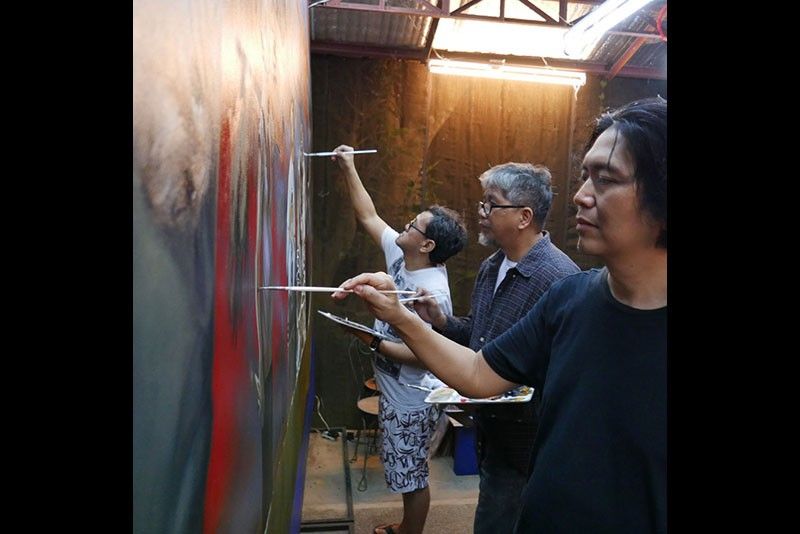Here, There, and Nowhere: Elmer Borlongan, Manny Garibay, and Mark Justiniani Paint a Nation Set in Limbo


A generation has passed since visual artists Elmer Borlongan, Manny Garibay and Mark Justiniani began painting their outrage on the streets, amplifying the uproar of rallies in the volatile daze of the ‘80s.
Part of collectives such as Artista ng Bayan (ABAY), Salingpusa and Sanggawa, the three artists made murals evoking the socio-political issues of their time. Their works were strongly critical and combative, depicting the massacres, the assassinations, and the letdowns right after the People Power Revolution’s widely publicized euphoria.
It has been 20 years since the three have collaborated, and with the mural they’re mounting at this year’s Art Fair Philippines, the mood is just as menacing yet the agon is subdued. No, the extrajudicial killings aren’t here, but as the ominous sky suggests, it’s as though the same angered souls are howling and hovering just around it.
“The theme of our mural is national identity,” explains Borlongan. “We started thinking about where the country is heading now that there’s a new administration. Are we going to revise history? Where are we going to base who we are as a nation now?”
Anchored on the prehistoric Manunggul Jar representing the dead’s voyage to the afterlife, the work entitled “Tagadagat” introduces fabled, imagined and historical figures: a Muslim with a sword, the makapili disclosing the identities of rebels, the pregnant woman holding an eagle, and the businessman with a farmer’s sickle. On each side are rowers paddling in the opposite direction, suggesting that the boat is (or perhaps we are) going nowhere.
“It’s more of an introspection on the many facets of who we are, mainly tayo bilang Pinoy,” says Garibay. Here, there are no raging men on the streets shoving their wrath and riot into the minds of spectators — but rather, old ghosts already looming in the collective memory of a nation.
As three so-called angry artists who have developed — or, as they describe it, “matured” — over the years, the painting similarly asks which questions artists should probe, which narratives they control. “We’re not in a position to engineer culture like the big businesses do,” says Garibay. Unlike enterprises and politicians manufacturing beliefs, artists once designated under the flimsy banner of social realism have been expected to provoke and question, to dismantle and redefine.
Yet here, the painting is no longer issue-based, but inward looking. There are no figures symbolizing the shock of daily news. The only time-teller here is the suggestion that we are set in limbo, the point in history where we have no idea where we’re going.
“This is the time where we wait and see. It’s too early. Kakasimula pa lang,” says Justiniani of the new political regime. “And yet, you know that this is the turning point.”
In limbo hour, rowers act like two mad Sisyphuses peddling us to nowhere. Here are the artists who once painted the city, and now their city is made of water: a place devoid of structure, map and definition.They wrestle less with issues in a particular place, and rather with the identity of a nation that never rests on solid ground.
“There’s more search for meanings rather than solutions,” says Garibay. Rather than portraying yesterday’s dead body on the street, the mural draws attention to specters set in limbo: figures and symbols eroded in favor of society’s newer myths.
“For instance, the west is urging us to think and live more like them,” says Garibay. “They are the proponents of greed and sacralizing greed. We start to think that’s what life is all about: everything that has to do with consumption. If Filipinos realize it’s okay being themselves, then in the end, they won’t lose themselves in the practice of appropriating, imitating, copying.”
Depicting the anting-anting and the female priest reminiscent of the prehistoric babaylan, the mural returns us to a certain moment: when folklores and traditions reigned before the western canons of consumerism.
As Justiniani explains, the very title “Tagadagat” evokes how Filipinos saw the world in prehistoric times. “It’s a palindrome: reverse (the word) and it’s the same. Parang ‘alaala’ — baliktarin mo, ‘alaala’ pa rin.”
With the two rowers and the mirroring heads at the center, the painting itself is a visual palindrome — harking back to pre-colonial belief systems inscribed in the native language. “‘Lupa’ is the earth; ‘ulap’ is the sky. They share the same letters,” explains Justiniani. “When you look up ‘tingala,’ reverse it, it’s ‘langit.’”
Long before the age of technology and the building of roads, Filipinos conjured the collapse of distance between the earth and the sky. “We viewed the world more holistically,” says Justiniani. “Now, I think, we have an important belief. And this does not apply to our climate, our environment, our sensibilities.”
Perhaps the violence that the mural echoes is how collective memory is revised, spoiled and raped through the eras. The artists coax us to recall who we are or what we have forgotten. Identity is memory, a limbo of nameless ghosts. Or perhaps identity is a myth that artists have long been in the business of creating.
Borlongan, Garibay and Justiniani liken painting the mural to the Philippine tradition of bayanihan — or, as Justiniani puts it, like playing in a band. The process itself is symbolic of a local tradition as the mural presents a portrait of the Filipino through the gaze of the art world’s rock stars.















